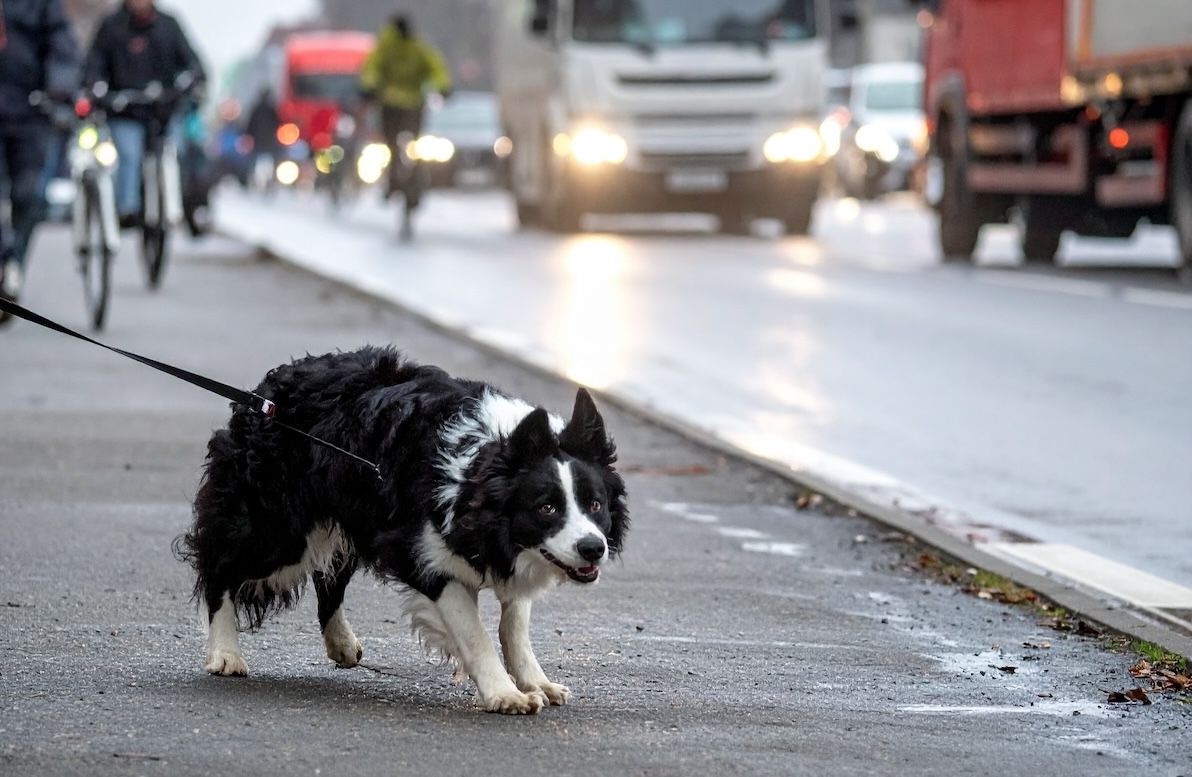
There’s a persistent myth in the dog world that collie traffic chasing is just “herding behaviour” or "controlling movement."
However, when you really look into the different experiences the collie has when meeting sheep and when they chase, nip or lunge in other contexts, we can start to see why many of the behaviours we label as “herding” are actually fear-based responses.
This is especially true when it comes to traffic chasing.
Just because Border Collies were bred to herd sheep, that doesn’t mean that every chase, snap or lunge is a calculated working move. It DOES mean that they are movement and sound sensitive, they often behave impulsively, and that they struggle in busy, loud environments.
So what is it that causes them to bark, lunge, chase, and attempt to nip at passing vehicles?
“Isn’t It Just Herding?” – Why That Assumption Is Misleading
Many owners really struggle with their car chasing collies. It's a serious behavioural problem that results in many collies ending up in rescue, and being returned again and again to rescue after rehoming.
When a Collie lunges at cars, it's often brushed off as “herding instinct.” But this label is so misleading. It implies purpose, control, and a positive mindset.
Let’s think critically:
- Does the dog appear calm, thoughtful, and in control of their body?
- Are they attempting to use eye and body pressure to move the vehicle somewhere?
- Are they stopping and starting based on feedback from the “flock”?
Or are they stiff, frantic, lunging unpredictably, eyes wide, ears back, breathing shallow, strangling themselves on the lead, sometimes nipping?
I have yet to meet a car-chasing collie who is trying to herd traffic. They have all been scared, they have a history of trying to make themselves look big and daunting to make the scary thing go away, which has worked. They therefore have a highly reinforced habit grounded in fear and anxiety.
Understanding this distinction is vital—because if we assume they’re just herding, we’re likely to miss the fact that they’re actually distressed.
Herding Sheep vs. Encountering Traffic: A World Apart
Meeting sheep
Let's consider how most working collies are first introduced to sheep. It's in the countryside, the surroundings are quiet. There are no unfamiliar people, dogs or other scary things. The pups observe the sheep either from a distance or from behind a fence. The sheep are calm, quiet and move organically. Some may saunter over to investigate. They are not noisy, bright, splashy, or smell of fumes. They behave relatively predictably. The pup has plenty of room to move away if it wants to - and most do move away - as sheep are big and scary to a pup. There are a few sheep and then they are gone, and it's peaceful and quiet again.
Meeting traffic:
Compare this to most collies' first experience of traffic which occurs after their inoculations on their first walks at 13 weeks old. From their perspective, at ground level, these huge, very loud, strange-smelling, bulky mechanical monsters move towards them faster than anything else they may have encountered, with spinning wheels, potentially with lights shining, and loud splashing noises if it's raining. The ground may shake with larger vehicles. They are on a short lead, often on the restricted space of a path by the road. They have no concept of being safe on paths.

The loud scary monsters appear, one after another, again and again, repeatedly. It's an absolute affront to the collies' senses. Similarly frightening is when vehicles suddenly appear on quiet roads (often without a path at all), loud, looming and overpowering, and then are gone. The poor dogs have no idea what just happened.
Even as collies start to become more familiar with traffic, individual encounters with exceptionally fast, loud or big vehicles, such as motorbikes, buses with airbrakes or rattly trailers can trigger a startle response and potential phobia. They are terrified and it's usually these early experiences that trigger traffic chasing.
These two scenarios couldn't be more different.
To put things in perspective, putting a young dog into a small pen of sheep, which is still relatively less stressful than walking by a busy road, would put many collies off sheep for life. Shepherds would avoid this until their collies are older and more confident with sheep. And it's a technique often used by trainers who claim to STOP dogs chasing sheep.
To Summarise
Meeting Sheep
🐑Usually in quiet, rural areas
🐑 Sheep move away from the dog
🐑 Open areas for the dog to escape
🐑 Calm, ambient sound environment
🐑 Scent of grass, soil, livestock
🐑 Gradual introduction and guidance
🐑 Predictable, organic movement
🐑 Visual contrast is soft and natural
🐑 The dog builds confidence gradually
🐑 Off-lead, with choice and agency
🐑 Often supported by an experienced handler
Walking Near Traffic
🚗 Typically in busy, noisy urban or suburban areas
🚗 Vehicles often move towards the dog
🚗 Narrow pavements with no room to escape
🚗 Loud engines, horns, air brakes, tyre screeches
🚗 Smell of exhaust fumes, oil, hot metal
🚗 Sudden exposure—often first walk after vaccinations
🚗 Erratic, fast, sometimes jerky movement
🚗 Reflections, bright lights, shadows on concrete
🚗 The dog is often overwhelmed and scared from day one
🚗 On a short lead, with tension and no room to move
🚗 Owner may feel panicked, unsure, or reactive themselves
So What Is Happening When a Collie Chases Cars?
When a dog chases traffic, they’re often:
- Startled by sudden motion
- Frustrated by their lack of control or escape options
- Scared of the noise, vibration, or proximity
- Flooded by accumulated stress from the environment (trigger stacking)
- Reinforced because the car always goes away—so the dog feels it “worked”
And when you combine high arousal, confinement, and a lack of coping strategies, you get lunging, barking, chasing, and sometimes biting.
That’s not herding. That’s panic with legs.
And when dogs live in environments where they are unable to avoid traffic, then anxiety medication helps to reduce the behaviour - further confirmation that the main emotion behind car chasing is fear.
What Can We Do Instead?
We must start by understanding the emotions that our collies are experiencing, not just focusing on their behaviour. From there, we can support them with:
- Safe, calm exposure to traffic from a distance at which they feel safe
- Using distance to maintain calm behaviour, and rewarding this
- Freedom of movement using a harness and long line
- Avoiding tight spaces until the dog feels more confident
- Managing the environment to prevent further overwhelm
- Ruling out pain or sensory issues, which can make reactivity worse
- Veterinary support, where needed (some fearful dogs benefit greatly from medication—to help them to cope if avoiding traffic is not possible)
Final Thought
Border Collies are very sensitive, intelligent, impulsive and emotionally complex dogs. Labelling these problem behaviours as "herding" or attempts to "control movement" dismisses their distress and does collies a disservice. It means that we aren't addressing the real emotion behind the behaviour, and helping them to get over their fears and anxieties. There are rare occasions when collie car chasing is not related to fear, but they are so rare that I've never seen it yet.
If it feels like fear… it probably is.
And they deserve our support—not assumptions.


I have this problem with my 4yr old make Border Collie all the as fine walking on streets until he reached 1yr old. Then he wanted to lunge at cars nothing would distract him even favourite treats. I had to avoid lots of streets with cars as it got too dangerous. Then the Dogfather ‘Graeme Hall’ helped us Tommie was on Dogs behaving badly Australia 2024 we slowly got him desensitised to cars and I was able to walk streets again but it’s started back up again as we moved house 😱😱 he also does this same thing in my car lunges at the windscreen to attack on coming cars HELP !! I really appreciate your comments such interesting reading Thankyou
Good luck with him – hopefully you can get help. Don’t let any other trainers tell you he is “just herding”!